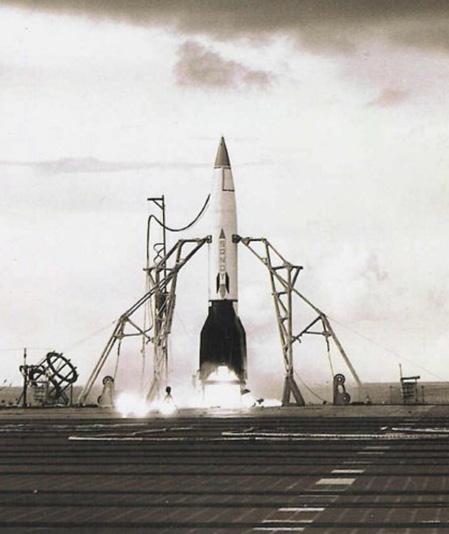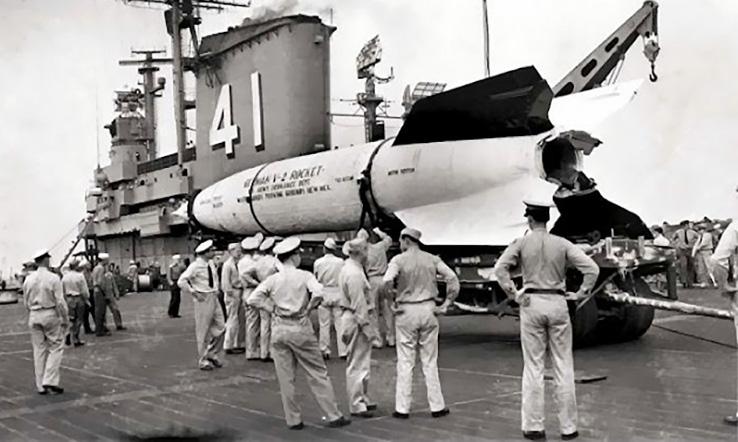
4 minute read
Midway Magic - USS Midway Museum
OPERATION SANDY
After preliminary conferences between naval officials and ordnance personnel at White Sands along with the German rocket scientists who had defected to the United States after the war, Adm. Chester Nimitz, then the chief of naval operations, determined it would be feasible to launch a V-2 missile from the flight deck of an aircraft carrier at sea.
75th Anniversary of V-2 Rocket Launch on USS Midway

America’s missile program took flight in the closing days of World War II with the establishment of the White Sands Proving Grounds in the high desert of south-central New Mexico in July 1945. Early U.S. military rocket tests proved successful, but with limited capabilities.
Enter the V-2 rocket.
Developed by the Germans before the start of World War II, more than 3,000 V-2 rockets would ultimately rain down on England, France and Belgium for several months starting in late 1944 killing an estimated 9,000 civilians and military personnel. Following the cessation of hostilities in Europe in May 1945, hundreds of components of captured Nazi V-2s were brought to the United States accelerating the country’s fledging ballistic missile program. The first test launch of V-2 was conducted at White Sands on April 16, 1946.
Over the next year and half, nearly 30 V-2s lifted off from Launch Complex 33. It wasn’t long, however, before discussions began on the potential of firing a large rocket from a Navy warship. On May 22, 1947, Operation Sandy was established, and the USS Midway was designated as the aircraft carrier to conduct the V-2’s test launch. Rear Adm. Daniel Gallery, the assistant chief of naval operations for guided missiles, oversaw the project.
“The primary purpose of Operation Sandy was to find out some of the answers to the problem of launching a larger bombardment type rocket from a ship at sea,” said Gallery, who was in command of a naval task force the captured a German U-boat off the western coast of Africa in June 1944. “Lessons learned from this operation will be applied to the future design of guided missiles for naval use and to design a new type of warship, the guided missile ship, which may eventually be as important to the fleet as the present-day aircraft carrier.”
Within a few weeks, a select group of officers and enlisted personnel from Midway headed to White Sands for intensive training in the preparation, handling and launching of a V-2 rocket. Ultimately, the Army’s ordnance department was directed to provide two live rockets for the test launch and a dummy V-2 for continued training purposes on the ship.
The date for the launch on Midway was set – Sept. 6, 1947.
By August, the Midway’s crew training was complete, and preparation had begun to ship the rockets and support equipment to the east coast. Midway was berth at the Norfolk Naval Shipyard adjacent to the railroad tracks and cranes needed to get the V-2s to and on board the ship.
On Sept. 2, with all the gear aboard and preparations finalized, Midway, along with four Navy destroyers, put to sea and headed to launch area approximately 250 miles south of Bermuda.
At 3:53 p.m. on Sept. 6, the rocket was ignited. Two seconds after launch, the V-2 tilted starboard 45 degrees continuing its liftoff in the direction of Midway’s flight-deck island. While most of Midway’s crew was below deck, Neal Casey, one of the ship’s fire control technicians, was part of the tracking team assigned to follow the V-2 once it launched and call its range down to the plotting room. Positioned on the island near the bridge, Casey estimated the rocket missed the superstructure by 100 yards. “I had no problem tracking the rocket,” said Casey, an 18-year-old Oklahoma native. “It almost hit the island when it launched.”
On the bridge was helmsman Gordon Vandiver. He too had a front row seat for the launch watching as the rocket veered towards the island after takeoff. “The thing was headed straight for us,” recalled Vandiver, an Ohio native who had just turned 18. “You never saw so many scrambled-egg officers dive for cover in all your life. A lot of brass turned green in an instant.”

Within a few seconds, the V-2 returned to a vertical attitude and rose normally. Shortly thereafter, however, the rocket’s flight profile became erratic and it went out of control and broke up at approximately 12,000 feet. The rocket broke into three main sections and fell into the ocean a little more than three miles from Midway.
While the V-2 did not obtain the desired trajectory, it satisfied the major objectives of the test and was considered a success.
“This experiment marked the beginning of a new era in naval weapons,” said Gallery in the operation’s afteraction report. “Operation Sandy demonstrated the practicability of launch the war-proven German V-2 missile from a modern aircraft carrier without interfering with the primary purpose of that vessel. The rocket was successfully launched for the first time from a ship underway at sea. It was the opening phase in an extensive program leading to the adaptation of naval vessels and the logistics of naval operations to the use of this new weapon.”










